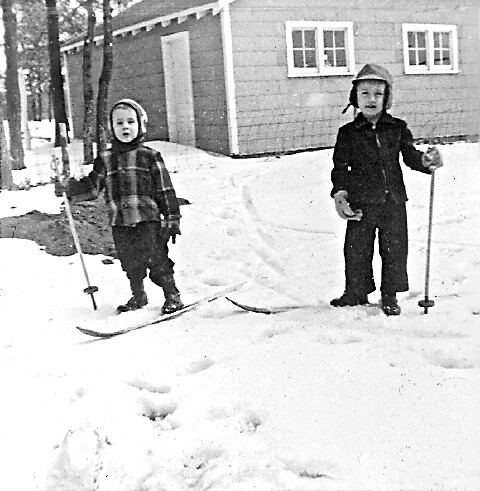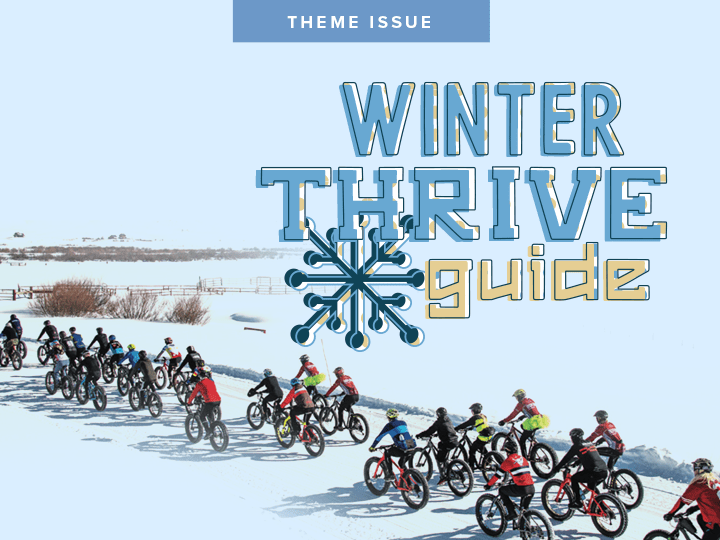Over the Hill and Still Skiing
a local winter memory

As a kid, my idea of a great way to spend a winter afternoon consisted of curling up behind the couch with a handful of cookies and a volume or two of the World Book Encyclopedia. Things changed, thankfully.
Getting out from behind that couch was one of the better moves of my life. It led not only to downhill skiing, but to snowshoeing and cross-country skiing. And with those extensions on my feet, there are no boundaries except time to keep me from exploring and experiencing our winters.
We may owe one of our sisters for prompting the change. She and my younger brother and I, at the start of my 10th winter, took advantage of the foot of early December snowfall to head off to a steep hill in a nearby pasture. She carried an ancient pair of homemade skis that had hung in our garage and we’d never seen in use. My 6-year-old brother Joe and I pulled the toboggan and trailed along. As the sun lowered, she put her snow boots in the single leather straps, held the bamboo poles, and headed straight down the hill.
It was one of the spectacular sights of our young lives. Our sister flew downslope, unhindered by any restraint, skill, or judgment. But when, beneath the snow, the grassy hillside gave way to plowed furrows, her skis stopped suddenly and she flew upward and forward in an incredible swan dive. She landed head-first and lay in a crumpled heap in the snow.
“Duke, Joe, come here! I’m hurt,” she said between moans.
We, of course, thought it was a hilarious scene, and laughed and whooped on the hilltop. But it must have been serious, because she didn’t even bother to threaten to kill us. Eventually, we rode the toboggan down the hill, making ambulance siren sounds until we reached her.
Her forehead was bruised and bleeding, and her arms were oddly bent beneath her. We guessed that the situation was indeed serious. I trudged off home to get our dad while Joe sang Christmas songs to our sister. When she returned from the hospital with casts on each of her broken wrists, she had almost two months to remind us of the event.
But the accident led to our parents to get us real ski equipment the next season, and turn us over to a real instructor at the tiny three-rope tow ski hill six miles away. Now, 46 years of skiing later, I think I’ve concluded that winter is, well, all right.
My sister eventually healed from her injuries and became a smooth and disciplined skier. But she never, ever would let herself get out of control after that December evening.
Somehow, both my brother and I worked our way onto ski patrols at Midwestern resorts, treating skiers and snowboarders who had been injured. This will be my 33rd year of patrolling in the western part of Michigan’s Upper Peninsula. Perhaps it’s a sort of penance. Sometimes I wonder, but in reality it’s kept me out there and involved. Skiing became one of our family’s favorite activities.
Being out there has introduced me to some of my favorite places and put me there at the best of times.
Lots of people take up a sport such as football, basketball or soccer and find they can only do it part of their life. Though I dabbled in a number of sports with results ranging from forgettable to painful to merely mediocre, skiing and snowshoeing have been sports I can master, and ones I plan to enjoy all my life.
My wooden snowshoes have given me the quiet wintertime gift of walking along dark-flowing rivers, of flushing grouse bedded under the fluffy snow, and seeing wolves, deer, or turkeys in their home turf. I can make my own trails or follow others, and get back and away from the sounds of snowmobiles or traffic. A couple of times, perhaps, I took too much advantage of their freedom and got far out in sketchy weather, or went through the ice of a creek that should have been better frozen. But those challenges didn’t detract from the overall feeling of self-reliance and adventure the activity gave me.
Cross-country skiing came a little later, a gift from my soon-to-be wife, and we have enjoyed moonlight skis and evening outings with our spaniels running alongside (and occasionally on) our skis. Five Birkebeiners and other long-distances cross-country ski races have given me the chance to train hard as I wished, develop techniques and friendships with other long-distance skiers, and gratefully hang up the skis after each late February marathon from Hayward to Cable.
Even though I no longer ski the xc marathons, that last Saturday in February you will always find me outside – often on a downhill run in the UP – just standing and thinking of the way the sun glints off motes of powder snow filtering through the red pines on the hills near the Seeley Fire Tower on the Birkie Trial. The memories of its beauty overwrite those of the pain, in muscle and joint, of the 35-mile race.
After a lifetime of activity and varying degrees of extra weight, my knees were giving up the struggle. The past several years, they hurt when I did almost everything, from skiing to walking in the woods to wading in streams. My balance suffered and it was painful to move quickly to catch myself when I tripped or slipped. It wasn’t that I couldn’t do things, but that the price I paid was becoming too high to enjoy them.
Last winter, I underwent successive total knee replacement surgeries, and missed the first ski season since 1963 for hospital stays, therapy, and regaining my function. It was a struggle, but worth it. My doctor tells me I may have to give up skiing double-black diamond mogul runs in the mountains, and I try to make it look like that will be a major sacrifice.
This summer I’ve been back to wading streams, walking the woods, and biking. The change is marvelous. In a couple of weeks we’ll be back in the UP to ski again. I am sure to take some time to just stand and gaze out over the 40 miles of forest to Lake Superior, blue-gray in the winter afternoon light. I’ll ponder how good it feels to be back, and what it will look like when I stand there in another couple of decades, still on my skis.

